Photographic Compositions
Gallery Kayafas
Boston, MA
September 7 – October 13, 2012
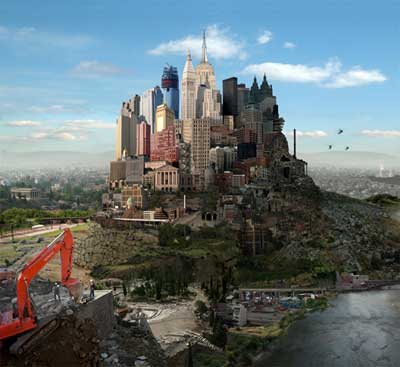
Courtesy of the Artist
and Gallery Kayafas
There is a beautiful, crowded music in these photographic constructions by Julie Holcombe, something symphonic, evoking charm via chaotic amalgamations of modern life.
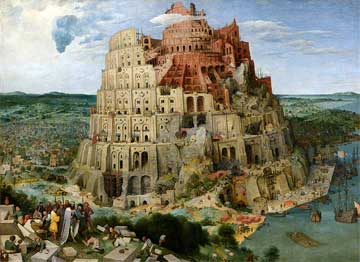
“The Tower of Babel” (ca 1563)
Oil on panel
Courtesy: Kunsthistorisches Museum, Vienna
Rather than, as the great contemporary photographer Andreas Gursky frequently does, finding a kind of uniform blur in contemporary urban architectural phenomena, she composes similar elements to create variegated but harmonious, conjunctions that commemorate difference.
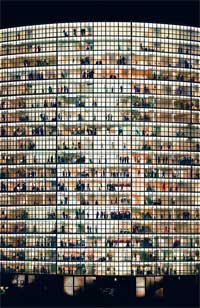
The series made emblematic by Babel Revisited (image shown above) represents that vividly. It shows a composite of buildings, many from New York, but (according to Holcombe, with whom I was able to speak at this show) also from Cleveland and other cities. They are gingerly compressed into one another, then placed on a kind of hill within a surrounding landscape. The hill (again, according to Holcombe) is inspired by the Athenian Acropolis.
This print conveys, as background, the chaos that the Biblical tale of Babel connotes, but there is greater contemporary irony here, suggesting how the jumble of modern life a certain kind of coherence, and dignity, through humor. We live in a jumble, but, if we can keep smiling and see the beautiful collages embedded in that jumble, all is not lost.
Architects’ Dream shows, as does Babel, an aggregate, but with an amalgamation of elements derived from Las Vegas, the world capital of whimsical architectural design. One can only smile at this celebration of the wild variety of compositional languages spoken there.
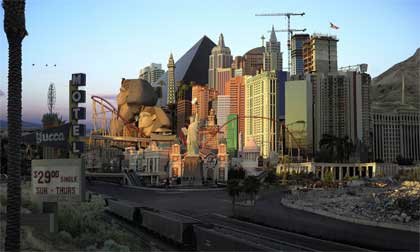
Courtesy of the Artist
and Gallery Kayafas
A series of vertically elongated pieces seemingly inspired from Chinese and Japanese scroll paintings, shows imagistic amalgamations done less noticeably than in the Babel series, with vertical sweeps that contain transitions that are almost unrecognizable as edits.
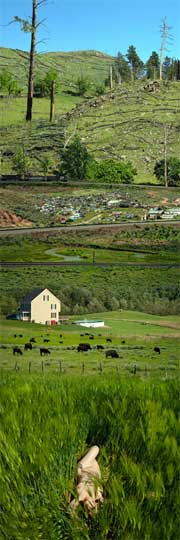
“Days of No Tomorrow”
Courtesy of the Artist
and Gallery Kayafas
Days of No Tomorrow shows a nude at the bottom of a seamlessly layered landscape, vertically elongated very much like a Chinese scroll. A clear cut hill stands over a car junkyard, which in turn stands over a bison herd grazing, all of which hovers over the nude, somehow conveying the sense of her constructing all of this in a complex dream.
Consider the following scroll from fourteenth century China, of the sort from which Holcombe might have taken her inspiration. There is no dreaming nude, but the scene is green, fanciful, and endlessly elongated.

“The Simple Retreat”
(Yuan Dynasty, ca 1370)
Hanging scroll
Ink and color on paper
Courtesy: The Metropolitan Museum of Art
New York
A series, seemingly inspired by interiors done by the Dutch masters of the seventeenth century, creates lovely compositions with the sense of perspective Vermeer might have used, but with indisputable contemporary imagery.
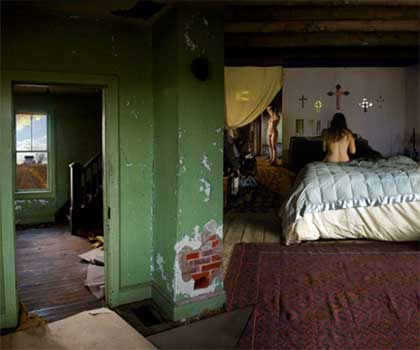
Courtesy of the Artist
and Gallery Kayafas
Fox in the Hen House (2010) shows two nudes sitting in a tenement, its red brick crying out through broken plaster. A bucolic farmhouse peers through a window, and crosses shine on the opposite wall. It is a vividly constructed print, full of visual counterbalances and echoes.

“The Music Lesson” (ca 1662-1665)
Courtesy Royal Collection
St. James’ Palace, London
Allegory of Melancholy (2012) shows a woman regarding a skull. An array of newspapers and crumpled pieces of paper, wine bottles, pill bottles and mannequin heads strewn across the floor sit before a wall of books. On the one hand, it has the comparative sedateness of a Dutch interior, and an equivalent madness of modern life gone awry.
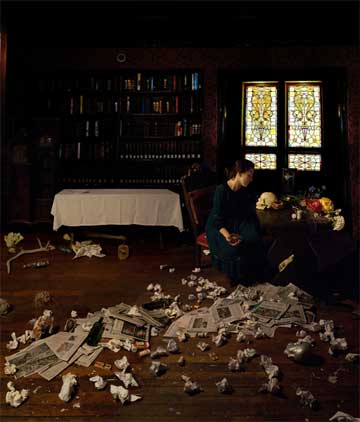
Courtesy of the Artist
and Gallery Kayafas
In these Dutch interior improvisations, as in the Babel and the Chinese Scroll series, the templates of the inspiring forms shine through while we smile at the disjunctions between them and their modern applications.
These inventive amalgamations are evocations of the traditional forms on which they are based, and wonderful, trenchant reconstructions of modernity, serving both to commemorate them and to cast an ironic eye on their differences.
– BADMan
Leave a Reply